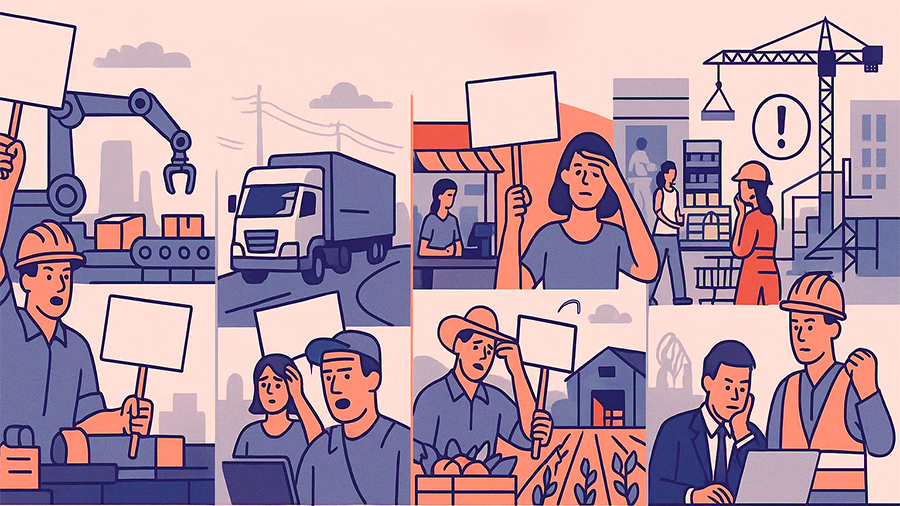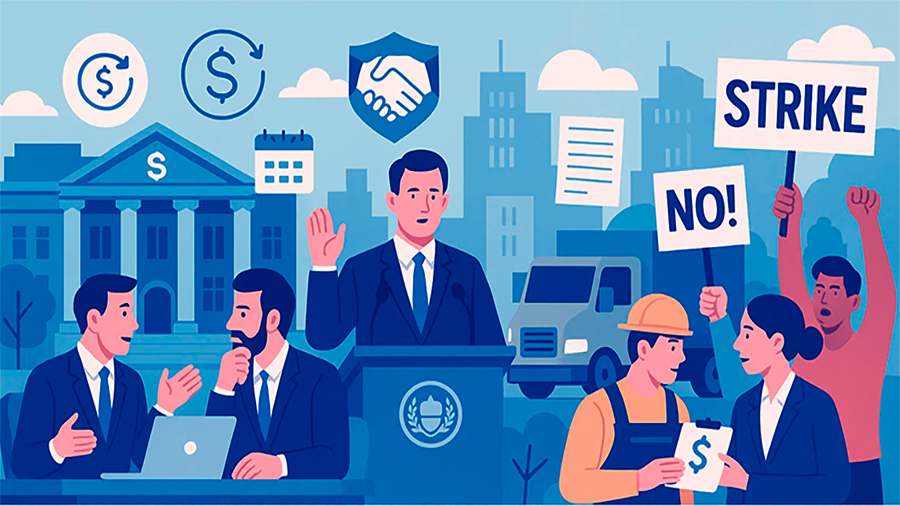Financing Survival: The Role of Credit in Labor Protests
Credit as a Cushion for Business During Labor Protests
Labor protests are among the most challenging disruptions a business can face. Unlike predictable seasonal downturns or planned maintenance shutdowns, strikes and protests often arrive suddenly, halting production lines, closing transport routes, and scaring away customers. Revenues drop overnight, yet obligations remain. Salaries must be paid, suppliers expect settlement, and lenders demand repayment. In these moments, credit becomes a cushion—providing liquidity, covering fixed costs, and keeping companies alive until protests subside. Businesses that secure credit access before or during unrest can ride out turbulence and return to stability, while those without it risk default, layoffs, or even collapse.
Why Protests Trigger Immediate Financial Strain
Mass protests create financial stress because they interrupt the flow of money without reducing obligations. A retail chain in a city center may face weeks of reduced foot traffic as demonstrations discourage customers. A factory hit by strikes cannot ship finished products, leaving sales on hold. Logistics companies find roads blocked, forcing them to cancel deliveries. Despite this, businesses must continue paying employees, rent, utilities, and existing loan installments. Cash reserves dry up quickly, especially in sectors with tight margins. Access to credit helps bridge this mismatch between falling revenue and ongoing expenses. By borrowing, businesses maintain trust with workers, suppliers, and clients, which becomes critical once operations resume. Without credit, a temporary protest can cascade into contract breaches, layoffs, and long-term reputational harm.
Credit Tools That Support Businesses During Strikes
Not all financing is equal during times of protest. Short-term credit tools are particularly valuable because they provide quick access to funds when cash flow collapses. Working capital loans cover immediate operating expenses such as payroll or rent. Overdraft facilities allow companies to draw funds as needed, offsetting sudden revenue gaps. Trade finance instruments help importers and exporters manage cash flow when shipments are delayed. Revolving credit lines provide ongoing access to funds without requiring repeated applications, offering flexibility during uncertain protest durations. Businesses often rely on a combination of these instruments, using loans for fixed costs, overdrafts for day-to-day expenses, and trade finance for international contracts. The speed and flexibility of these tools make them essential safety nets in periods of unrest.
Examples of Credit Use
| Credit Instrument | Purpose | Example |
|---|---|---|
| Working capital loan | Ensure wages and bills are paid | A textile mill secures funds to pay workers during a two-week strike |
| Overdraft facility | Offset sharp sales declines | A supermarket chain covers supplier invoices despite lower revenue |
| Trade finance | Bridge delayed exports | An agricultural exporter uses credit to honor contracts during port blockades |
| Revolving credit line | Provide ongoing liquidity | A logistics operator taps funds to reroute deliveries during protests |
Industries Most Vulnerable to Labor Protests
Some industries feel the pressure of protests more acutely than others. Manufacturing firms face direct losses when assembly lines stop, as fixed costs continue without output. Logistics and transportation companies suffer from route blockages, fuel waste, and penalty fees for delayed deliveries. Retailers in affected areas see sales plunge, yet must still pay staff and suppliers. Agricultural exporters risk spoilage when crops cannot leave warehouses or ports. Even service providers—from IT firms to construction contractors—struggle if employees join protests or clients suspend projects. Each sector has unique vulnerabilities, but all rely on credit to bridge the gap between halted operations and financial obligations.
Sector-Level Impacts
| Industry | Impact of Protests | Role of Credit |
|---|---|---|
| Manufacturing | Production halts, revenue evaporates | Loans cover wages, rent, and energy bills |
| Logistics | Routes blocked, deliveries canceled | Credit funds rerouting, covers penalty fees |
| Retail | Reduced customer traffic, unsold stock | Overdraft sustains supplier payments |
| Agriculture | Spoilage of perishable goods | Trade finance ensures exporters meet obligations |
| Services | Employee participation in strikes | Credit cushions payroll during stalled projects |
Real-World Examples of Credit as a Safety Net
Across the world, businesses have relied on credit to survive labor protests. In South America, soybean exporters used trade finance to maintain contracts when port blockades delayed shipments. Without access to credit, they would have faced penalties from international buyers. In Europe, logistics firms turned to revolving credit lines to reroute trucks during border worker strikes. Although costs rose, credit allowed them to avoid customer defaults. In Asia, textile factories accessed overdraft facilities to keep paying staff during prolonged strikes, preventing worker attrition. In North America, construction companies drew on working capital loans to cover costs when union protests paused building projects for months. These stories underline a clear theme: credit prevents temporary unrest from escalating into permanent business failure.
How Credit Helps Preserve Relationships
The role of credit during labor protests is not only financial but relational. By ensuring payroll, companies signal loyalty to workers even during unrest. By paying suppliers on time, they preserve vital supply chain ties. By honoring client contracts with the help of financing, they maintain credibility in the marketplace. For example, a logistics firm using a credit line to deliver goods via alternate routes may absorb higher costs, but it preserves its long-term client relationships. A retailer covering supplier payments with overdraft facilities ensures it receives priority shipments when protests end. These relational benefits are as important as the financial cushion itself. Businesses that maintain trust during unrest often recover faster and stronger than those that default on obligations.

Lenders and Government Roles During Labor Unrest
Lenders also adapt to the realities of labor protests. Banks may restructure loans, extend repayment terms, or expand overdraft limits for affected businesses. Some develop specialized credit products for industries at high risk, such as logistics or agriculture. Governments often step in with guarantees or emergency credit lines, ensuring that financing continues to flow even in volatile times. For example, European governments have occasionally backed loans for transport operators during strikes to prevent systemic breakdowns. In Latin America, state-owned banks provided liquidity to exporters during widespread protests, avoiding mass defaults. This cooperation between lenders, governments, and businesses ensures that credit remains available, preventing unrest from triggering a broader economic crisis.
Additional Illustrations Across Sectors
Beyond headline cases, many smaller stories highlight the importance of credit during labor protests. A bakery chain in Eastern Europe used a short-term loan to keep ovens running and staff paid during citywide demonstrations, ensuring loyal customers returned once stability resumed. A mining company in Africa drew on trade finance to cover supplier contracts when rail blockades stopped ore shipments. An IT outsourcing firm in Asia relied on revolving credit to cover payroll after protests delayed a major client project. A farming cooperative in North America accessed overdraft facilities to buy protective equipment and secure goods during farmer protests. Each example reflects the same principle: credit sustains continuity during temporary disruptions, protecting long-term survival.
The Conclusion
Labor protests expose businesses to severe liquidity shocks. Sales decline, deliveries fail, and operations pause, yet fixed costs and obligations continue. Credit fills this gap, giving companies the cushion they need to keep paying wages, honoring supplier contracts, and maintaining client trust. From working capital loans to trade finance and revolving credit lines, financing tools transform chaotic strikes into manageable financial challenges. Examples from manufacturing, logistics, retail, agriculture, and services show that firms with credit access recover faster and suffer less damage. For lenders and governments, supporting credit flows during unrest is equally important to prevent systemic breakdowns. Ultimately, credit is more than a financial product—it is a resilience strategy that shields businesses from the unpredictable storms of labor protests.


